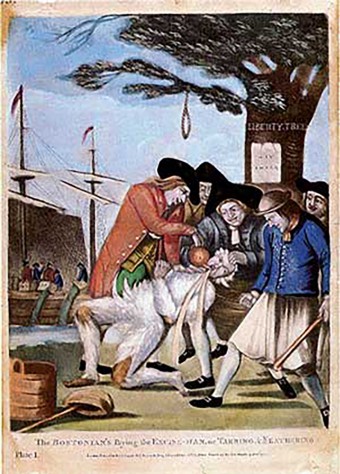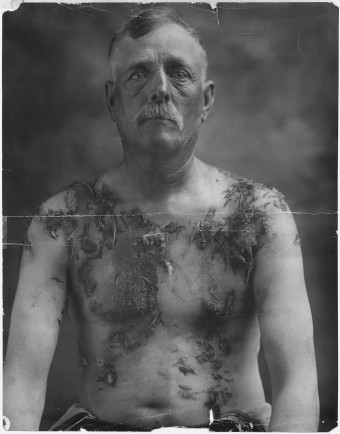Tarred and Feathered
 In times gone by, tarring and feathering was a go-to method used by mobs to punish or otherwise humiliate criminals or people believed to have wronged the community in some way.
In times gone by, tarring and feathering was a go-to method used by mobs to punish or otherwise humiliate criminals or people believed to have wronged the community in some way.
While it’s mostly recognised as being a punishment handed down in colonial times, the history of tarring and feathering stretches back all the way to the crusades and possibly further, with the earliest known recorded reference to the punishment being an edict passed down by Richard the Lionheart in 1189.
According to the King Richard’s decree, if one of his soldiers was found stealing from his fellow crusaders, he was to be shaved and then coated in boiling pitch before having a “cushion of feathers” poured over his head; the thief would then be left stranded in whichever country they happened to anchor in next.
While the explicit wording King Richard used suggested that the punishment wasn’t meant to be fatal, it’s not difficult to see how pouring hot pitch over someone could prove deadly, especially in a time before antibiotics to treat inevitable infections from severe burns. The most common injuries from the tarring and feathering itself were indeed burns and blisters. After the individual was then thoroughly humiliated, perhaps by parading them around town in a nude or semi-nude state, he or she also tended to find it very difficult to get the tar and feathers off without potentially losing a little skin in the process, leaving behind a lasting testament to their shame in the forms of scars.
Because tarring and feathering was a punishment most often handed down by angry mobs, which aren’t exactly known for their restraint, individuals subjected to the punishment were also sometimes severely beaten. For example, in 1832 a Mormon minister named Sidney Rigdon and his friend, none other than Joseph Smith himself, were almost killed when a mob dragged them from their homes in the dead of night, severely beat them while trying to force-feed them acid before tarring and feathering them and leaving them both for dead. Amazingly, both men were able to survive this horrifying ordeal. Unfortunately, Smith’s baby, who was left exposed to the elements during the event, was not so lucky, dying shortly after.
From all this, you might be surprised to learn that most people who were tarred and feathered survived the ordeal. How?
Well, in most cases the tarring and feathering was simply meant to humiliate the individual in question, not kill them. As such, pine tar was commonly used, which has a relatively low melting point, typically around 130-140 degrees Fahrenheit (55-60 C); certainly hot enough to cause an exceptional amount of discomfort and burns, but nothing like the harm that would be caused by various forms of melted petroleum based tar. Further, depending on the severity of the perceived crime or slight against the masses, the pine tar may not, in some cases, be melted and then poured on, but simply heated a little and then roughly rubbed on the individual to leave enough residue on their skin for the feathers to stick- painful to be sure, but at least perhaps avoiding the burns.
So if the goal was to cause excruciating pain and death, boiling pitch or coal tar could be used, along with severe beatings. But given the very good survival rates we have record of, it would appear this was rarely what those administering the tar and feathers were going for; survivable pain and humiliation were the name of the game in most cases, both during the tarring and feathering and after, with the individual finding it exceedingly difficult to get the tar off. If the mob wanted to kill the person, they had more expedient and less elaborate methods for that, such as hanging.
If you liked this article, you might also enjoy our new popular podcast, The BrainFood Show (iTunes, Spotify, Google Play Music, Feed), as well as:
- The Curious Practice of Execution By Golden Shower
- Do Egg Whites Really Make a Good Burn Treatment?
- What Happens When You Freeze Water in a Container So Strong the Water Can’t Expand Into Ice?
- What Happens When You Stick Your Head Into a Particle Accelerator
- What Happens If a Cemetery Goes Under?
Bonus Facts:
- During the American Revolution, mobs supporting both sides of the conflict made frequent use of tar and feathers. It’s thought that tarring and feathering became the go-to punishment during colonial times partially because of the vast amounts of pine tar that was readily available in nearby shipyards. It has also been suggested that Patriots and British supporters were inspired to tar and feather one another because of how popular it was in 18th century England as a way of humiliating tax collectors who would often be paraded and dragged through the streets.
-
Even after the American revolution ended, tarring and feathering remained a popular form of mob “justice” right up through the first half of the 20th century. A particularly famous case is that of John Meints, a German-American farmer who in 1918 was dragged from his Minnesota home, whipped and threatened with guns before being tarred, feathered and forced to march half-naked across the border of the state to South Dakota. He was then told if he ever returned, he’d be killed. Meints later tried to sue the men who kidnapped and abused him, only for the jury to declare them innocent of all charges. The judge in the case, Wilbur F. Booth, even advised the jury that they should consider Meints disloyal to the United States in contemplating their verdict. You see, Meints had the audacity to be German-American around WWI. In the end, Meints was reasonably lucky to escape with his life considering how many comparable cases had ended with lynchings. Meints had the last laugh, though. In 1922, he was able to get a new trial and managed to settle the whole affair out of court, receiving $6,000 (about $84,000 today) in damages.
- Over in Europe following WWII, women who’d dared to have relations with German soldiers were occasionally subjected to tarring and feathering, whilst in Ireland tarring and feathering was used extensively during the 1970s by the IRA to punish alleged criminals or women accused of fraternising with the British, which has inspired similar cases as recently as 2007!
| Share the Knowledge! |
|






You incorrectly stated that they were tarred and feathered nude or semi-nude which is incorrect. They wdere stripped only to the waist not ever nude.
This has been discussed repeatedly after the recent release of John Adams miniseries on HBO. They show Adams being stripped nude so they can show his genitals in the very common female chauvinistic approach HBO normaly takes. They were willing to make the miniseries historically incorrect by adding men’s genitals after which they began selling the miniseries to our schools so our children will now see the incorrect history and men’s genitals.
HBO, under the direction of Sheila Nevins, a devout female chauvinist sow, has done countless scenes in in most of their programming that degrades and exploits men by showing their genitals but never showing women’s genitals.
It is important to get these facts correct. They did not strip people naked, only to their waist and HBO showed this invorrectly so they could exploit and degrade men again.
Yes people were stripped nude and pitch tar with temperatures starting at 140 degrees and up was used. Some women in Belgium had the tar pushed inside their private parts and butt as well. There are pics on the internet that show some of them.
“Meints had the audacity to be German-American around WWI. In the end, Meints was reasonably lucky to escape with his life.”
How pretentious to pretend that in our “enlightened” world we are any different from our progenitors. This is the “hope and change” attitude that creates nails in the coffin or our beautiful world like ISIS.
For the transgression of a land many are the princes thereof: but by a man of understanding and knowledge the state thereof shall be prolonged. Prov 28:2
You got the gist but missed the point. 1918 was the last year of World War I – a conflict largely considered to have been initiated by the German Nation (for the young people who don’t know zilch about history). Stay with me. Hostilities were running high – logically, fairly, justifiably, or not; this man was targeted because he was German in the USA at that time.
What this proves, if anything, is that discrimination, unfairness, racial (or national bias) can occurr anytime with with any people – collateraly, bilaterally, or unilaterally – more or less any which way but loose. Only the names of the people change. It’s a human folly. Nobody’s not guilty.
My grandfather was part German. In 1932 he was killed in a terrible industrial mishap; leaving two small sons and a wife to get by without a father or provider at the beginning of what would come to be the greatest depression this country had known. If I had to say, given the innate horror surrounding this event and it’s unspeakableness in family; it may very likely not have been an accident.
If it wasn’t an accident; he was guilty of nothing other than being of German extraction 12 years subsequent of World War I – ’cause he was a decent man and a good father.
This is the nature of people and their lunacy; everwhere, every day, all over the world.
The author is correct – the incident was sparked by hostilities related to World War I.
People were stripped completely nude when tarred and feathered. I know because I was tarred and feathered by a group of women when I was 20
They took every stich of clothing off me and rode me around town naked in a pickup truck.
Robert, How old are you now , If you don’t mind me asking ? And what did you do , to make them so angry to tar (molasses) and feather you then Parade you around Town in a pickup truck ?